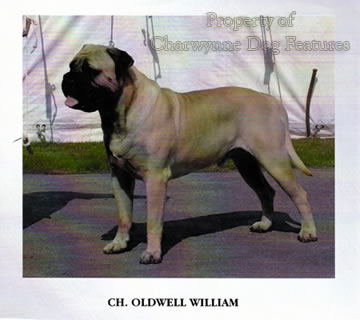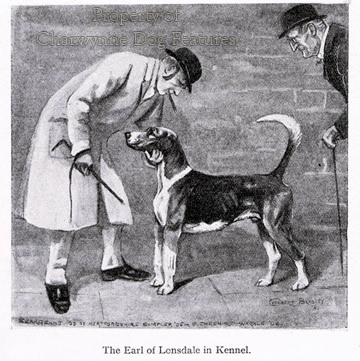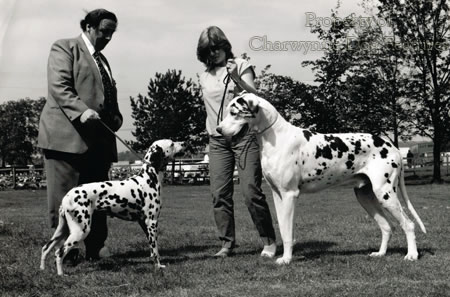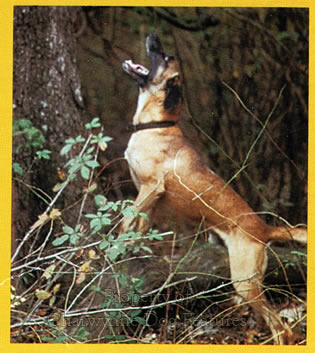800 BUILDING A FUNCTIONAL DOG - The Role Of The Shoulders
BUILDING A FUNCTIONAL DOG - THE ROLE OF THE SHOULDERS
by David Hancock
 Every breed standard approved by the Kennel Club stresses the importance of shoulders. Every competent show ring judge must judge shoulders with a knowledgeable eye. Every breed of dog is expected to move! Without a sound front action a dog struggles to obtain balanced movement, adequate forward extension and fluid economic locomotion. Foxhound judges place great emphasis on the position of the elbow. I suspect that if they were given the chance to judge, say, Airedales and Fox Terriers, even at Crufts, they would withhold all prizes and write a pain-giving critique. Again and again, show judges comment adversely on shoulders in their critiques; again and again the same flawed entry turns up at the next show; this doesn't earn respect.
Every breed standard approved by the Kennel Club stresses the importance of shoulders. Every competent show ring judge must judge shoulders with a knowledgeable eye. Every breed of dog is expected to move! Without a sound front action a dog struggles to obtain balanced movement, adequate forward extension and fluid economic locomotion. Foxhound judges place great emphasis on the position of the elbow. I suspect that if they were given the chance to judge, say, Airedales and Fox Terriers, even at Crufts, they would withhold all prizes and write a pain-giving critique. Again and again, show judges comment adversely on shoulders in their critiques; again and again the same flawed entry turns up at the next show; this doesn't earn respect.
One Airedale critique of ten years ago read: "It makes no sense for a breeder to keep a puppy that shows an incongruity between the size of upper arm and shoulder blade...every breeder knows that a well-laid back shoulder demands an upper arm of the same length." The SWKA Airedale judge of 1997 wrote: "Movement in Airedales has deteriorated to the extent that I cannot honestly say that any one of the ones I judged could be classed as having excellent movement. The best I would rate as passable and the worst as appalling." The 1998 Crufts Airedale judge wrote: "Movement is still a problem...One of the reasons is the absence of really laid back shoulders." The 1999 Crufts Airedale judge wrote: "Movement, as always, is not as it should be." The following year at Crufts, a different judge reported: "Movement is shocking...come on you Airedale breeders...own up to the faults in your dogs..." Two years later, at the Midland Counties Airedale Club November show, the judge wrote: "The modern Airedale lacks the drive and rhythm of its forerunners moving and it appears that little is happening to attempt a remedy to offset such a situation. This may be in part due to there being too few who can remember true Airedale movement..." This makes a sad judgement on Airedale breeders but without due attention it can happen in any breed; it's a warning to all.
In the Bullmastiff breed standard, the shoulders are expected to be 'muscular, sloping and powerful, not overloaded'. This, for me, is far too brief and open to false interpretation. In his informative book on the Dogue de Bordeaux, Raymond Triquet writes on shoulders for that breed: "A wrestler's shoulders. The muscles are prominent. The shoulder blade is set at the normal angle of around 45 degrees to the horizontal...this oblique lay and the mobility of the shoulder allow the D de B to take those long strides mentioned in the paragraph on gait...The angle of the shoulder blade with the upper arm is said to be somewhat more than 90 degrees. It's very difficult to measure, but it will be about 100 degrees (normal in a short-lined or compactly-built dog). In any case, it's clearly seen in profile: the upright front leg stands back a little, underneath the body."
Upright shoulders are becoming acceptable in many breeds; judges don't seek that 'upright front leg standing back a little, underneath the body', which Raymond Triquet stresses. In most show terriers there is no 'bump in the front', just a smooth uninterrupted line from throat to toes. Thirty years ago many of the Oldwell and Bunsoro Bullmastiffs had beautiful shoulders and the judges rewarded them. When they moved they drove themselves over the ground; when the front leg is too far forward, the dog pulls itself along, a very tiring exercise. A good judge should be able to spot whether the elbow is back and under the body, to detect a lack of forward extension and a front action which pulls rather than pushes on the ground.
If in any breed there are too few conversant with correct movement, then a visit to a hound-show such as Peterborough, Honiton and Ardingly would be of enormous benefit. Breed clubs are on the whole incestuous, inward-looking and rarely innovative, their officials prefer to repeat the past than look to the future of their breed. The wording of breed standards on shoulders is usually quite good; the understanding of those well-chosen words however is less good. Expressions like 'lay of shoulder', 'well-laid shoulders' and 'sloping shoulders' are used by many without any clear concept of their implications, and, more important, the reason for their inclusion. Tom Horner, the great terrier breeder and judge, wrote authoritatively on this very point.
In his informative book 'All About The Bull Terrier' of 1973 (Pelham Books), Horner wrote: "...to secure the very important good lay back of shoulders, it is necessary for the dorsal bones to be of good length. Well laid back shoulders are highly desirable for a number of reasons, a well laid shoulder has a firmer attachment to the chest wall than an upright one, it is also likely to be matched by a good length of upper arm, which, in turn, will mean that the elbow will be placed well back from the forechest, and the foreleg will have freedom to reach out well in movement." The stilted abbreviated front movement of so many show ring terrier breeds illustrates the limitation imposed on a dog's forward movement by a lack of slope in the shoulders and a lack of length in the upper arm. But this restricted handicapped forward action is actually praised by some ignorant TV commentators at Crufts, daring to call it typical terrier gait!
For me, the first point of real quality in a dog lies in clean sloping shoulders. Well-placed shoulders give a perfect base for a proud head carriage. They provide too the balance between the length of the neck and the length of the back, preventing those disagreeable dips in topline which mar the whole appearance of a dog. I learned, over the years, to start any judgement of the shoulders by considering the position of the elbow. If the elbow is too far forward, then the dog is pulling itself along, not pushing itself along, capitalising on the drive from the hocks and thighs, through the loins. The great foxhound expert, Capt Ronnie Wallace, in his video on the packhounds, states that the shoulders are controlled by the elbow. He knows his stuff; he bred superbly constructed hounds.
It is only when the scapula and the humerus are of the right length and correctly placed that a dog can achieve the desired length of stride and freedom in his front action. Sighthounds can have their upper arms 20% longer than their scapulae. In smaller breeds they tend to be equal in length. Dogs which step short in front are nearly always handicapped by upright shoulders and short steep upper arms. A dog of quality must have sloping shoulders and compatible upper arms to produce a good length of neck, a firm topline without dips, the right length of back and free movement on the forehand. The upper arm determines, with its length, the placement of the elbow on the chest wall. Many dogs which are loose at elbow are tight at the shoulder joint and the forelegs tend to be thrown sideways in a circular movement. If the dog is tight at elbow the whole leg inclines outwards, causing the dog to 'paddle'.
When judging 'galloping breeds' I always check the space between their shoulder blades at the withers. If you check this space, say, to compare a show greyhound with a coursing dog, by placing a finger between the two scapulae and then getting the dog to lower its head, you can soon spot the difference. The show dog's scapulae will squeeze your finger as the dog's head goes down; the coursing dog's scapulae will remain apart. In extreme cases this means that the show specimen would be quite unable to pick up a rabbit or even drink from a bowl on the floor, without adjusting its forelimbs. It is not good sense for the Greyhound's standard to demand shoulders that are 'narrow and cleanly defined at the top'; this can create a difficulty when the dog lowers its head. 
The racing front involves an extremely long upper arm, often dropping the elbow below the brisket line. I have heard show judges declare this feature to be undesirable, even 'shelly'. But most of the desert Salukis I have seen hunt with great success possessed this feature, as do many quality lurchers. In the Dachshund front, the whole forehand structure is reduced in length of bones; the elbow action arc being actually above the brisket line. Not surprisingly, Dachshunds and Salukis move differently from Bullmastiffs. Most indifferent movement stems from a faulty forehand construction. The placement of the shoulder blades and the elbows being the source of the problem. The shoulder blades of a working breed are vitally important. They have to support weight, they absorb concussion from the gait, they work hard when the dog is changing direction, they permit free movement of the head. Loose elbows are often accompanied by other front leg faults: slack pasterns, splayed feet or feet which turn in or out. Dogs with correctly sloping shoulders and compatible upper arms rarely have such a problem.
When shoulders are correctly sloped, the topline runs through much more smoothly, giving a far cleaner look. The shortening of the neck from the forward placement of the shoulders does seriously impede a working dog. A retriever, for example, with such a feature has to make so much more effort to pick up game or carry it over an obstacle or when swimming with it. Short-necked dogs tire far more quickly than soundly constructed ones. A few years ago, when making a commercial video on the Labrador Retriever, we were filming on the Sandringham estate and it was a joy to see the quite beautiful necks and shoulders of the sleek very fast black Labs working there. No working dog deserves incompetent breeding bestowing handicapping features on it. When moving, 60 to 70% of a dog's weight is distributed on the front legs; the forequarter construction decides the soundness of the dog's movement. 
I once actually heard a speaker at a breed seminar argue that a short neck, upright shoulders and short upper arms made an exhibit look more impressive when stacked in the show ring. It allegedly made the dog stand right up on its toes and lift its head at a higher plane, so that it looked 'more statuesque'! I don't think I have ever heard a greater insult to show judges. If we are going to breed physically-crippled dogs to please mentally-crippled judges, then the sport of showing dogs is drawing to a close. But we do need judges who can assess forehand construction wisely. Working dogs need informed assessment; winning dogs get bred from. No dog with an unsound front assembly should ever be bred from.
Tom Horner wrote that 'Long-arched necks give flexibility to the head carriage and usually go along with good shoulder placement, the two combining to give the dog an air of quality and style'. Long cervical bones, long dorsal bones, a 'bump in the front', adequate upper arm length and a gap between the scapulae at the withers are not difficult to detect when viewing and 'going over' an exhibit. Two Bullmastiff judges' critiques in recent years on this aspect make sobering reading: Manchester, 2000; 'A worrying aspect was the number with incorrect shoulder placement, too many were far too upright, which not only unbalanced them in front, it also affected their overall action. This needs watching.' Crufts, 2004; 'Too many were upright in shoulder with short, steep upper arms, restricting movement so that there was virtually no forward extension...' For a powerful breed, sound construction is vital; for good movement, sound construction is essential.
In his book The Conformation of the Dog, RH Smythe wrote: "One reason why a sloping shoulder is preferable lies in the much freer and faster action which is associated with this type of conformation...A good shoulder is much more likely to be accompanied by a good length of chest and by additional lung space than one which is badly spaced." A famous Newmarket trainer used to stress 'No shoulder, no horse!' A famous professional huntsman advised 'Necks and shoulders! get the necks and shoulders and the rest will come!' These are the cries needed for soundly-built dogs; we select the breeding stock, so we shoulder the blame. If you want your Bullmastiff to move like an Airedale, ignore the crucial importance of shoulder placement. If you want your Bullmastiff to move like a Foxhound, give shoulders top priority. You might even, under an enlightened judge, win a prize for a sound dog; but more important still, you will be respecting your own sporting or working breed.